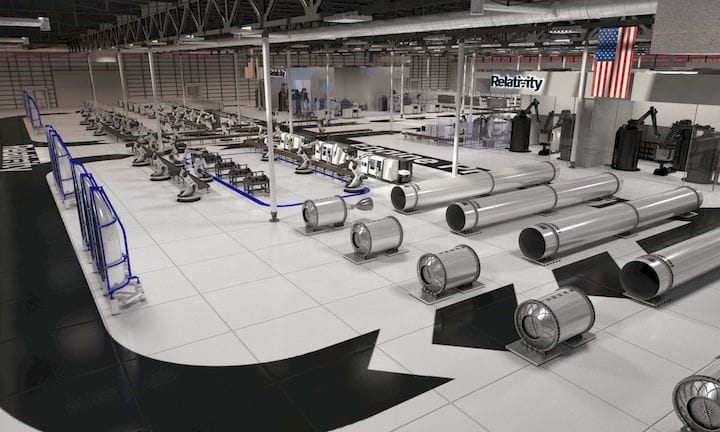![Concept image of Relativity Space’s proposed rocket factory [Source: TechCrunch]](https://fabbaloo.com/wp-content/uploads/2020/05/image-asset_img_5eb095dcf34df.jpg)
Relativity Space has signed a deal with NASA to develop a rocket-printing factory.
The California-based startup focuses on advanced rocketry through the use of their unique “Stargate” 3D printer. It’s a monstrously huge robotic metal 3D printer they say can dramatically speed up production. They say they can 3D print an entire rocket engine in only 60 days using their system.
Up to now they’ve had “only” four of their Stargate systems operating from their California base. Now they’ve made an agreement with NASA to implant up to 24 even larger 3D printers at the NASA Stennis Space Center in Mississippi, although the intent is to start operations with 12 systems.
According to a report on TechCrunch:
“Unlike other rocket manufacturers, Relativity uses 3D printers for almost all of the components it needs to assemble a spacecraft. The company says its technology significantly reduces the time it takes to manufacture a vehicle for space travel and the cost associated with that manufacturing.
At Stennis, the company has 220,000 square feet at its disposal to install second-generation printers, larger than the initial designs it has in its LA base of operations.
Initially, the company will be focused on the construction of its own Terran1 rocket design, and has signed up three customers, including Spaceflight Industries, Telesat and Mu Space for launches.”
This is a huge development for the startup company, which has, according to CrunchBase, raised US$45.7M in three known investment rounds. What’s interesting to me is that the Stennis investment is apparently US$59M, so it seems that Relativity Space has obtained, or will obtain, additional cash from another source.
Relativity Space Investment
This could be from an unknown previous investor, an unannounced investor, or — surprise — from ongoing sales! If the latter is the case, it would seem that Relativity Space would be so profitable that it is able to afford this huge expansion.
If that’s true, I am not so surprised. Their concept is a good one: if money is saved by 3D printing complex objects in one component, then why not scale that up and print more and more of the final machine? The amount of time and effort required to design, build, test, assemble, proceduralize, support and retire individual components is considerable, and when you combine parts together with 3D printing, you reduce all of that to a single set of actions. Mucho cost savings!
This concept should be quite attractive to rocketry customers, who otherwise lay out enormous sums for traditional rocket equipment. Saving even a percentage on such projects yields considerable dollars.
3D Printed Manufacturing?
Finally, if Relativity Space is successful in their manufacturing venture, it may be they gaze upon other markets that could take the same manufacturing treatment. Could they move into the automotive space, for example? We’ll see what happens.
Via TechCrunch











Years of experimentation are leading to affirmation: 3D printing in space, for in-space use, is looking viable.